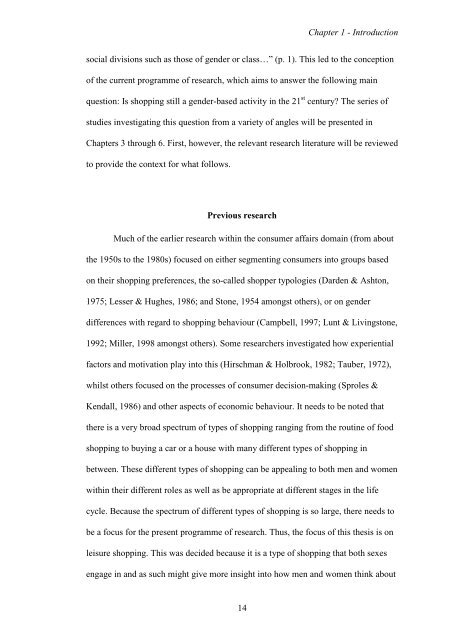CHAPTER 1 - University of Exeter
CHAPTER 1 - University of Exeter
CHAPTER 1 - University of Exeter
You also want an ePaper? Increase the reach of your titles
YUMPU automatically turns print PDFs into web optimized ePapers that Google loves.
14<br />
Chapter 1 - Introduction<br />
social divisions such as those <strong>of</strong> gender or class…” (p. 1). This led to the conception<br />
<strong>of</strong> the current programme <strong>of</strong> research, which aims to answer the following main<br />
question: Is shopping still a gender-based activity in the 21 st century? The series <strong>of</strong><br />
studies investigating this question from a variety <strong>of</strong> angles will be presented in<br />
Chapters 3 through 6. First, however, the relevant research literature will be reviewed<br />
to provide the context for what follows.<br />
Previous research<br />
Much <strong>of</strong> the earlier research within the consumer affairs domain (from about<br />
the 1950s to the 1980s) focused on either segmenting consumers into groups based<br />
on their shopping preferences, the so-called shopper typologies (Darden & Ashton,<br />
1975; Lesser & Hughes, 1986; and Stone, 1954 amongst others), or on gender<br />
differences with regard to shopping behaviour (Campbell, 1997; Lunt & Livingstone,<br />
1992; Miller, 1998 amongst others). Some researchers investigated how experiential<br />
factors and motivation play into this (Hirschman & Holbrook, 1982; Tauber, 1972),<br />
whilst others focused on the processes <strong>of</strong> consumer decision-making (Sproles &<br />
Kendall, 1986) and other aspects <strong>of</strong> economic behaviour. It needs to be noted that<br />
there is a very broad spectrum <strong>of</strong> types <strong>of</strong> shopping ranging from the routine <strong>of</strong> food<br />
shopping to buying a car or a house with many different types <strong>of</strong> shopping in<br />
between. These different types <strong>of</strong> shopping can be appealing to both men and women<br />
within their different roles as well as be appropriate at different stages in the life<br />
cycle. Because the spectrum <strong>of</strong> different types <strong>of</strong> shopping is so large, there needs to<br />
be a focus for the present programme <strong>of</strong> research. Thus, the focus <strong>of</strong> this thesis is on<br />
leisure shopping. This was decided because it is a type <strong>of</strong> shopping that both sexes<br />
engage in and as such might give more insight into how men and women think about
















